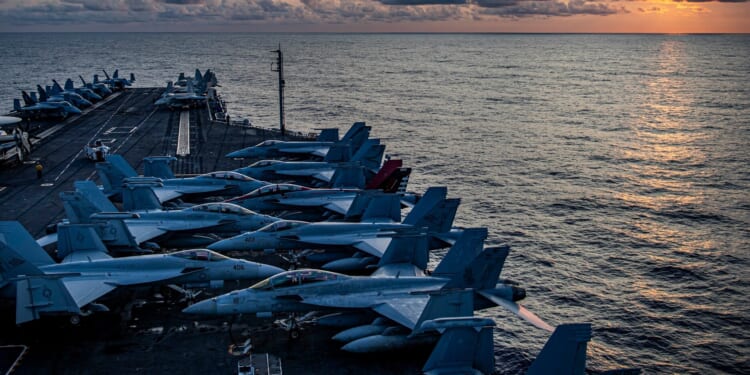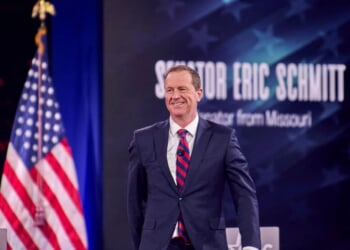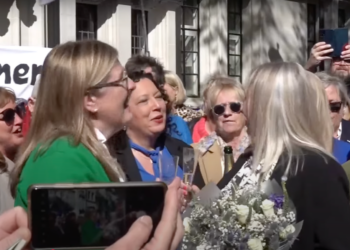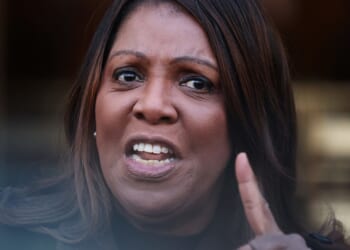On April 9, 2025, President Donald Trump issued perhaps his most important executive order to date. It is titled “Restoring America’s Maritime Dominance,” and it seeks, in the words of Naval War College chair of maritime strategy James Holmes, to create a “renaissance in U.S. maritime strategy.” Trump has taken a page out of the geopolitical playbook of President Theodore Roosevelt, who set in motion America’s first sea power renaissance.
Roosevelt became president at a pivotal time in U.S. history — the aftermath of the Spanish-American War when the United States emerged as a global power. Roosevelt’s friend and fellow naval enthusiast Alfred Thayer Mahan had urged America to “look outward.” Roosevelt, who as a young man had written a naval history of the War of 1812, agreed. In that book, the future president explained the essence of a great navy: “[S]hips well built, manned by thoroughly trained men, and commanded by able and experienced officers.”
Throughout his presidency, Roosevelt promoted the expansion of American naval power, and as James Holmes explained in Theodore Roosevelt and World Order, Roosevelt “discerned a symbiotic relationship among the Republic’s diplomacy, its economic interests, and the availability of a combat fleet able to stand toe-to-toe with the best Europe had to offer.” In remarks at the Naval War College before he was president, Roosevelt said, “ultimately those who wish to see this country at peace with foreign nations will be wise if they place reliance upon a first-class fleet of first-class battleships rather than any arbitration treaty which the wit of man can devise.” Holmes noted that Roosevelt applauded Mahan’s book The Problem of Asia because it urged the United States to form anti-hegemonic alliances to contain Asian-based land powers. And Roosevelt buttressed the Monroe Doctrine by declaring the need for the United States to build a navy and an isthmian canal in Panama that would enable our domination of the Western Hemisphere and the use of naval power to support the balance of power in Eurasia.
Roosevelt’s and Trump’s approaches to the world are eerily similar. Both are based on U.S. self-interest and foreign policy realism supported by a strong navy and geoeconomics. Both start with an appreciation of the importance of U.S. dominance in the Western Hemisphere, i.e, the Monroe Doctrine. Trump’s recent executive order promotes “rebuilding America’s maritime manufacturing capabilities,” which he calls the “Maritime Industrial Base.” “It is the policy of the United States,” Trump writes, “to revitalize and rebuild domestic maritime industries and workforce to promote national security and economic prosperity.” Trump orders a whole-of-government approach to this effort, directing his national security adviser, secretary of state, defense secretary, labor secretary, transportation secretary, homeland security secretary, the U.S. trade representative, and other executive branch agencies to come up with a “Maritime Action Plan.” (READ MORE: The Importance of Elbridge Colby)
Trump’s executive order is aimed directly at China, whose current shipbuilding capacity dwarfs that of the United States. It calls for an investigation of China’s unfair trade practices, especially in the shipbuilding and maritime logistics sectors. It also calls for increasing the size of our fleet of commercial vessels, recognizing that sea power encompasses more than just naval power. This is another example of Trumpian geoeconomics in support of geopolitics that Theodore Roosevelt would likely applaud.
Roosevelt as president was very careful to use American power as a means of promoting peace, not war. During his presidency, except for continuing to put down the Philippine insurgency begun under his predecessor, Roosevelt sought no new wars and spent considerable political capital in mediating great power conflicts (unlike his jingoism before and after his presidency). Trump, too, wants to be remembered as a peacemaker. He is working to mediate an end to the Russia-Ukraine War and bring calm to the Middle East. Trump’s “big stick” is directed at China, but even there his goal is to avoid war without ceding global supremacy to the Chinese Communist Party.
In 1907, Roosevelt launched America’s “great white fleet” on a cruise around the world, which received much press criticism but huge support among the American public. During the cruise, he urged Congress to expand the navy, noting the naval threat posed by Japan’s growing fleet of warships. President Trump’s executive order and Maritime Action Plan comes at a time of high tension in the South China Sea and the recent announcement by Russia that it will undertake a $100 billion naval expansion. As Holmes notes, Trump’s Executive Order “charts a path forward” to the rejuvenation of U.S. sea power, but he also solemnly warns: “The hour is late.”
READ MORE:


![Jasmine Crockett Justifies Mass Illegal Immigration With Bizarre Argument [WATCH]](https://www.right2024.com/wp-content/uploads/2025/03/1742007023_Jasmine-Crockett-Justifies-Mass-Illegal-Immigration-With-Bizarre-Argument-WATCH-350x250.jpg)
![Red Sox Fan Makes the ‘Catch of the Day’ with Unconventional ‘Glove’ [WATCH]](https://www.right2024.com/wp-content/uploads/2025/04/Red-Sox-Fan-Makes-the-‘Catch-of-the-Day-with-350x250.jpg)
![NYC Tourist Helicopter Falls into Hudson River, Siemens Executive and Family Among Those Killed [WATCH]](https://www.right2024.com/wp-content/uploads/2025/04/NYC-Tourist-Helicopter-Falls-into-Hudson-River-Siemens-Executive-and-350x250.jpg)

![Biden Drops Racial Slur During First Public Speech Since Leaving Office [WATCH]](https://www.right2024.com/wp-content/uploads/2025/04/Biden-Drops-Racial-Slur-During-First-Public-Speech-Since-Leaving-350x250.jpg)



![Green Day’s Cringe Trump Diss Ends in Fire and Evacuation [WATCH]](https://www.right2024.com/wp-content/uploads/2025/04/Green-Days-Cringe-Trump-Diss-Ends-in-Fire-and-Evacuation-350x250.jpg)





